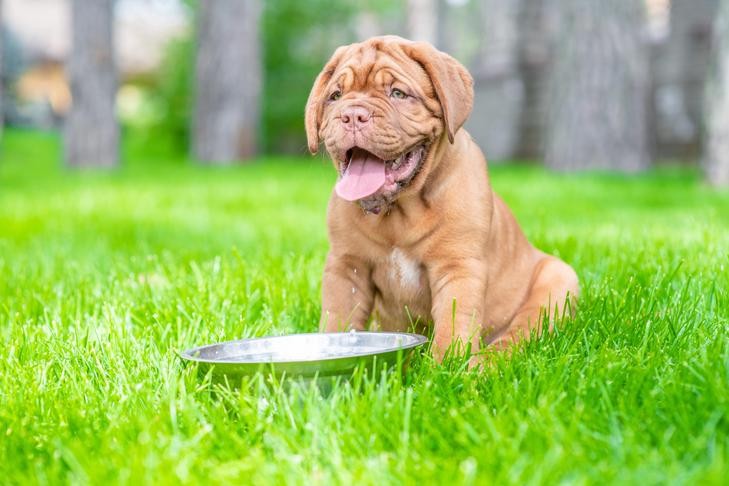What Is The Best Dog Food For Big Dogs? This is a crucial question for any owner who wants to ensure their large canine companion enjoys a vibrant and healthy life. At FOODS.EDU.VN, we understand the unique nutritional needs of large breeds. Finding the right food is the foundation for avoiding health problems, supporting strong joints, and maintaining optimal weight.
1. Understanding Nutrition for Large Breed Dogs
Large breed dogs have specific dietary requirements that differ slightly from those of smaller breeds. Like all dogs, they need a balanced intake of proteins, carbohydrates, fats, vitamins, and minerals. However, the proportions and sources of these nutrients are vital for managing their rapid growth and preventing potential health issues.
- Proteins: Essential for muscle development and repair. Look for high-quality sources like chicken, beef, fish, or lamb.
- Carbohydrates: Provide energy. Whole grains such as brown rice, barley, and oats are excellent choices.
- Fats: Crucial for energy and healthy skin and coat. Fish oil and flaxseed oil are great sources of omega-3 fatty acids.
- Vitamins and Minerals: Support overall health and well-being. These should be included in the appropriate ratios to prevent deficiencies or excesses.
According to a study published in the Journal of Animal Physiology and Animal Nutrition, large breed puppies are particularly sensitive to overnutrition, which can lead to developmental orthopedic diseases (DOD). Therefore, it’s vital to control their calorie and nutrient intake during their growth phase.
2. Tailoring Nutrition to Life Stages
The best dog food for big dogs changes as they move through different life stages. Puppies, adults, and seniors all have unique nutritional needs that must be met to ensure optimal health.
2.1. Puppy Food for Large Breeds: A Critical Start
Large breed puppies require special attention to avoid rapid growth, which can lead to developmental orthopedic issues.
-
Controlled Growth: Large breed puppy foods are formulated with lower levels of fat, calcium, phosphorus, and vitamin D to slow down the growth rate.
-
Preventing DOD: Overnutrition, particularly excessive calcium and phosphorus, is linked to DOD. Limiting these nutrients helps to reduce the risk.
-
Portion Control: Veterinarians often discourage free feeding for large breed puppies. Instead, feed measured portions multiple times a day.
It’s essential to consult with your veterinarian to determine the appropriate weight range for your puppy’s breed and to monitor their growth closely.
2.2. Adult Dog Food for Large Breeds: Maintaining Optimal Health
Once your large breed dog reaches adulthood, transitioning to an appropriate adult formula is crucial.
- Balanced Nutrition: Adult dog foods are formulated to maintain muscle mass, support joint health, and provide sustained energy.
- Joint Support: Many large breed adult formulas include glucosamine and chondroitin to support joint health and mobility.
- Weight Management: Monitoring calorie intake is essential to prevent obesity, which can exacerbate orthopedic issues.
A study in the Journal of the American Veterinary Medical Association emphasized the importance of maintaining a healthy weight in large breed dogs to reduce the risk of orthopedic disease and improve overall quality of life.
2.3. Senior Dog Food for Large Breeds: Addressing Age-Related Changes
As large breed dogs age, their nutritional needs change once again. Senior formulas are designed to address age-related health concerns.
- Lower Calorie Content: Senior dogs often have reduced activity levels and may require fewer calories to maintain a healthy weight.
- Increased Fiber: Fiber helps to support digestive health and prevent constipation, which can be common in older dogs.
- Added Supplements: Many senior formulas include antioxidants and omega-3 fatty acids to support cognitive function and reduce inflammation.
It’s important to remember that the term “senior” on dog food labels isn’t officially regulated, so it’s vital to consult with your vet. They can provide personalized recommendations based on your dog’s specific needs. - Prescription Diets: For senior dogs with specific health conditions, a prescription diet formulated by a veterinarian may be the best option.
3. Common Health Concerns and Nutritional Solutions
Large breed dogs are prone to certain health issues that can be managed or mitigated through proper nutrition.
3.1. Orthopedic Diseases
Orthopedic issues such as hip dysplasia, arthritis, and osteochondrosis are common in large breeds. Nutrition plays a vital role in prevention and management.
- Glucosamine and Chondroitin: These supplements support cartilage health and reduce inflammation.
- Omega-3 Fatty Acids: These fatty acids have anti-inflammatory properties that can help to alleviate joint pain.
- Weight Management: Maintaining a healthy weight reduces stress on joints and slows the progression of orthopedic diseases.
3.2. Obesity
Obesity is a significant concern for large breed dogs, as it exacerbates orthopedic issues and increases the risk of other health problems.
- Calorie Control: Feed measured portions and avoid overfeeding.
- High-Fiber Diets: Fiber helps to promote satiety and prevent overeating.
- Regular Exercise: Exercise helps to burn calories and maintain a healthy weight.
According to the Association for Pet Obesity Prevention, an estimated 53% of American dogs are overweight or obese. This highlights the importance of proactive weight management in large breed dogs.
3.3. Bloat (Gastric Dilatation-Volvulus)
Bloat is a life-threatening condition that is particularly common in large and giant breeds. While the exact cause is unknown, certain dietary factors can increase the risk.
- Multiple Small Meals: Feeding several small meals throughout the day, rather than one large meal, can help to reduce the risk.
- Avoid Elevated Feeders: Feeding from floor level is recommended, as elevated feeders may increase the risk of bloat.
- Limit High-Fat Foods: Foods with high-fat contents can slow gastric emptying and increase the risk of bloat.
- Large Kibble Size: Feeding foods with larger kibble size can encourage slower eating and reduce the risk of air ingestion.
According to the American Kennel Club, bloat can be fatal within hours, making prevention crucial.
4. Exploring Different Types of Dog Food
There are several types of dog food available, each with its own advantages and disadvantages.
4.1. Dry Dog Food (Kibble)
Dry dog food is the most common and often the most economical choice.
- Convenience: Easy to store, measure, and transport.
- Dental Health: The abrasive texture can help to reduce plaque and tartar buildup.
- Cost-Effective: Generally less expensive than wet food.
4.2. Wet Dog Food (Canned)
Wet dog food has a higher moisture content and can be more palatable for some dogs.
- Hydration: The high moisture content can help to keep dogs hydrated.
- Palatability: Often more appealing to picky eaters.
- Easy to Chew: Suitable for senior dogs or those with dental issues.
4.3. Raw Food Diets
Raw food diets, also known as BARF (Biologically Appropriate Raw Food), consist of uncooked meats, bones, and vegetables.
- Potential Benefits: Proponents claim improved digestion, increased energy, and healthier skin and coat.
- Risks: Potential for bacterial contamination and nutritional imbalances.
- Expert Consultation: Requires careful planning and consultation with a veterinary nutritionist.
4.4. Grain-Free Dog Food
Grain-free dog foods have become increasingly popular, but they are not necessarily healthier for all dogs.
- Allergies: May be beneficial for dogs with grain allergies or sensitivities.
- Nutritional Value: Ensure that the food is still balanced and provides all the necessary nutrients.
- Consult Your Vet: Discuss with your veterinarian before switching to a grain-free diet.
5. Deciphering Dog Food Labels
Dog food labels can be confusing, but understanding them is crucial for making informed choices.
- “Complete and Balanced”: Look for this statement, which indicates that the food meets the nutritional standards established by the Association of American Feed Control Officials (AAFCO).
- Ingredient List: Ingredients are listed in descending order by weight. Look for high-quality protein sources as the first ingredient.
- Guaranteed Analysis: Provides information on the minimum percentages of crude protein and crude fat, as well as the maximum percentages of crude fiber and moisture.
- Feeding Guidelines: These are just guidelines. You may need to adjust the amount you feed based on your dog’s individual needs.
- Avoid Unregulated Terms: Be wary of terms like “all natural” or “human-grade,” as these are not regulated and may not have any real meaning.
6. Determining the Right Amount to Feed
Determining how much to feed your large breed dog depends on several factors, including age, activity level, and metabolism.
- Body Condition Score (BCS): This is a visual assessment of your dog’s body fat. Your veterinarian can help you to determine your dog’s BCS and adjust their food accordingly.
- Feeding Guidelines: Use the feeding guidelines on the dog food label as a starting point, but be prepared to adjust as needed.
- Regular Monitoring: Monitor your dog’s weight and body condition regularly and adjust their food intake as needed.
7. Addressing Food Allergies and Sensitivities
Some large breed dogs may develop food allergies or sensitivities. Common symptoms include skin problems, digestive issues, and ear infections.
- Elimination Diet: This involves feeding your dog a novel protein and carbohydrate source for several weeks to see if their symptoms improve.
- Veterinary Diagnosis: Work with your veterinarian to diagnose and manage food allergies or sensitivities.
- Hypoallergenic Diets: These diets contain hydrolyzed proteins or novel protein sources that are less likely to trigger an allergic reaction.
8. The Cost of Feeding a Large Breed Dog
Feeding a large breed dog can be more expensive than feeding a smaller dog due to the larger amount of food they require.
- Budgeting: Factor the cost of dog food into your budget when considering getting a large breed dog.
- Quality vs. Cost: While it’s tempting to save money by buying cheaper dog food, it’s important to invest in a high-quality diet to support your dog’s health.
- Bulk Buying: Consider buying dog food in bulk to save money.
9. Seeking Expert Advice
Consulting with your veterinarian or a veterinary nutritionist is crucial for developing a lifelong nutrition plan for your large breed dog.
- Personalized Recommendations: Your vet can provide personalized recommendations based on your dog’s breed, age, health status, and lifestyle.
- Prescription Diets: If your dog has specific health concerns, your vet may recommend a prescription diet.
- Ongoing Support: Your vet can provide ongoing support and guidance to help you keep your dog healthy and happy.
10. Top Recommended Dog Food Brands for Large Breeds
While we can’t endorse specific brands (as preferences and individual dog needs vary), we can highlight key factors that make a dog food suitable for large breeds, which can guide your conversation with your vet. Look for brands that:
- Offer specific large-breed puppy and adult formulas
- Use high-quality protein sources
- Include joint support ingredients (glucosamine, chondroitin)
- Are transparent about their ingredients and manufacturing processes
- Have a good reputation and positive reviews
Remember, the best dog food is one that meets your dog’s individual needs and supports their overall health and well-being.
FAQ: Common Questions About Large Breed Dog Food
1. What makes dog food specifically for large breeds different?
Large breed dog foods have adjusted nutrient ratios, especially lower calcium and phosphorus levels in puppy foods to prevent rapid bone growth.
2. How do I know if I’m feeding my large breed puppy too much?
Monitor their body condition. You should be able to feel their ribs without excessive fat covering. Consult your vet for guidance.
3. Are grain-free diets better for large breed dogs?
Not necessarily. Unless your dog has a diagnosed grain allergy, a grain-inclusive diet can be perfectly healthy.
4. Is wet or dry food better for large breeds?
Both can be suitable. Dry food is more convenient and better for dental health, while wet food can help with hydration.
5. How often should I feed my adult large breed dog?
Two meals a day is generally recommended to prevent bloat.
6. What are the key ingredients to look for in large breed dog food?
High-quality protein sources, glucosamine and chondroitin for joint support, and balanced levels of fat, carbohydrates, vitamins, and minerals.
7. How important is it to follow the feeding guidelines on the dog food label?
The guidelines are a starting point, but you may need to adjust based on your dog’s individual needs and activity level.
8. What should I do if my large breed dog is a picky eater?
Try different flavors or textures, warm the food slightly, or add a small amount of wet food to dry food.
9. At what age is a large breed dog considered a senior?
Generally, around 6-7 years old.
10. Can I make my own dog food for my large breed dog?
Yes, but it requires careful planning and consultation with a veterinary nutritionist to ensure it’s nutritionally balanced.
Conclusion: Nurturing Your Gentle Giant
Choosing the best dog food for big dogs is a crucial aspect of responsible pet ownership. By understanding their unique nutritional needs and working closely with your veterinarian, you can help your large breed companion thrive and enjoy a long, healthy, and happy life.
Ready to take the next step in optimizing your large breed dog’s health? Visit FOODS.EDU.VN for more in-depth articles, expert advice, and resources to help you make informed decisions about your dog’s nutrition and overall well-being.
Discover a world of culinary knowledge and expert advice at FOODS.EDU.VN. Your journey to becoming a more informed and skilled food enthusiast starts here.
Contact Us:
- Address: 1946 Campus Dr, Hyde Park, NY 12538, United States
- WhatsApp: +1 845-452-9600
- Website: foods.edu.vn


